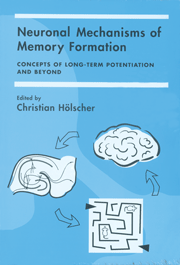Book contents
- Frontmatter
- Contents
- Contributors
- Introduction: Long-Term Potentiation as a Model for Memory Mechanisms: The Story So Far
- Section One Long-Term Potentiation In Vitro and In Vivo: How Can We Fine-Tune the Current Models for Memory Formation?
- 1 Persisting with Long-Term Potentiation as a Memory Mechanism: Clues from Variations in Long-Term Potentiation Maintenance
- 2 Long-Term Potentiation in the Amygdala: Implications for Memory
- 3 Multiple Roles for Synoptic Plasticity in Pavlovian Fear Conditioning
- 4 Plasticity of the Hippocampal Cellular Representation of Space
- Section Two There is More to the Picture Than Long-Term Potentiation: Theta or Gamma Oscillations in the Brain and the Facilitation of Synaptic Plasticity
- Section Three Making Models from Empirical Data of Synaptic Plasticity
- Section Four Setting the Stage for Memory Formation: Stress, Arousal, and Attention
- Section Five Transgenic Mice as Tools to Unravel the Mechanisms of Memory Formation
- Conclusions and Future Targets
- Index
1 - Persisting with Long-Term Potentiation as a Memory Mechanism: Clues from Variations in Long-Term Potentiation Maintenance
Published online by Cambridge University Press: 13 October 2009
- Frontmatter
- Contents
- Contributors
- Introduction: Long-Term Potentiation as a Model for Memory Mechanisms: The Story So Far
- Section One Long-Term Potentiation In Vitro and In Vivo: How Can We Fine-Tune the Current Models for Memory Formation?
- 1 Persisting with Long-Term Potentiation as a Memory Mechanism: Clues from Variations in Long-Term Potentiation Maintenance
- 2 Long-Term Potentiation in the Amygdala: Implications for Memory
- 3 Multiple Roles for Synoptic Plasticity in Pavlovian Fear Conditioning
- 4 Plasticity of the Hippocampal Cellular Representation of Space
- Section Two There is More to the Picture Than Long-Term Potentiation: Theta or Gamma Oscillations in the Brain and the Facilitation of Synaptic Plasticity
- Section Three Making Models from Empirical Data of Synaptic Plasticity
- Section Four Setting the Stage for Memory Formation: Stress, Arousal, and Attention
- Section Five Transgenic Mice as Tools to Unravel the Mechanisms of Memory Formation
- Conclusions and Future Targets
- Index
Summary
SUMMARY
Studies of long-term potentiation (LTP) induction and persistence in awake animals have revealed intriguing regional differences. LTP and heterosynaptic LTD in the dentate gyrus both inevitably appear to be decremental in nature, with the time constant of decay related to the strength of the induction stimulus. On the other hand, nondecremental LTP can be induced in area CA1 with a very mild stimulus that, when given in the dentate gyrus, evokes little or no LTP at all. CA1 synapses can also exhibit decremental LTP. LTP in neocortex has so far been observed only after multiple, spaced tetanization episodes, but this LTP can then be quite long-lasting. These data indicate intriguing differences in the pattern of LTP persistence across brain regions that may reflect different contributions to the memory or information storage process in behaving animals.
The dentate gyrus and CA1 appear to differ in a number of ways at molecular, cellular, and network levels that could account for the apparent differences in LTP persistence. These include the ability to produce voltage-dependent calcium channel (VDCC)-dependent LTP, the contribution by catecholamines to the persistence of LTP, the pattern of constitutive gene expression, and the pattern of tetanic stimulation commonly used to study LTP in these two regions. Few of these features appear to strongly differentiate the two hippocampal regions, however, making it conceivable that the dentate gyrus has the inherent capacity for nondecremental LTP, if only the right induction conditions could be met. Indeed, apparently nondecremental LTP has been reported for perforant path synapses in studies that have employed electroconvulsive shocks.
- Type
- Chapter
- Information
- Neuronal Mechanisms of Memory FormationConcepts of Long-term Potentiation and Beyond, pp. 37 - 57Publisher: Cambridge University PressPrint publication year: 2000
- 2
- Cited by



